This hibachi-inspired fried rice recipe is a perfect mix of simplicity and rich flavors. Whether you’re enjoying it as a quick weeknight dinner or serving it as a side dish, this recipe delivers every time. Made with perfectly cooked rice, savory soy sauce, tender vegetables, and scrambled egg, it’s the ideal way to recreate takeout-style fried rice at home! Plus, it’s customizable, so you can tailor it to your tastes and dietary needs.
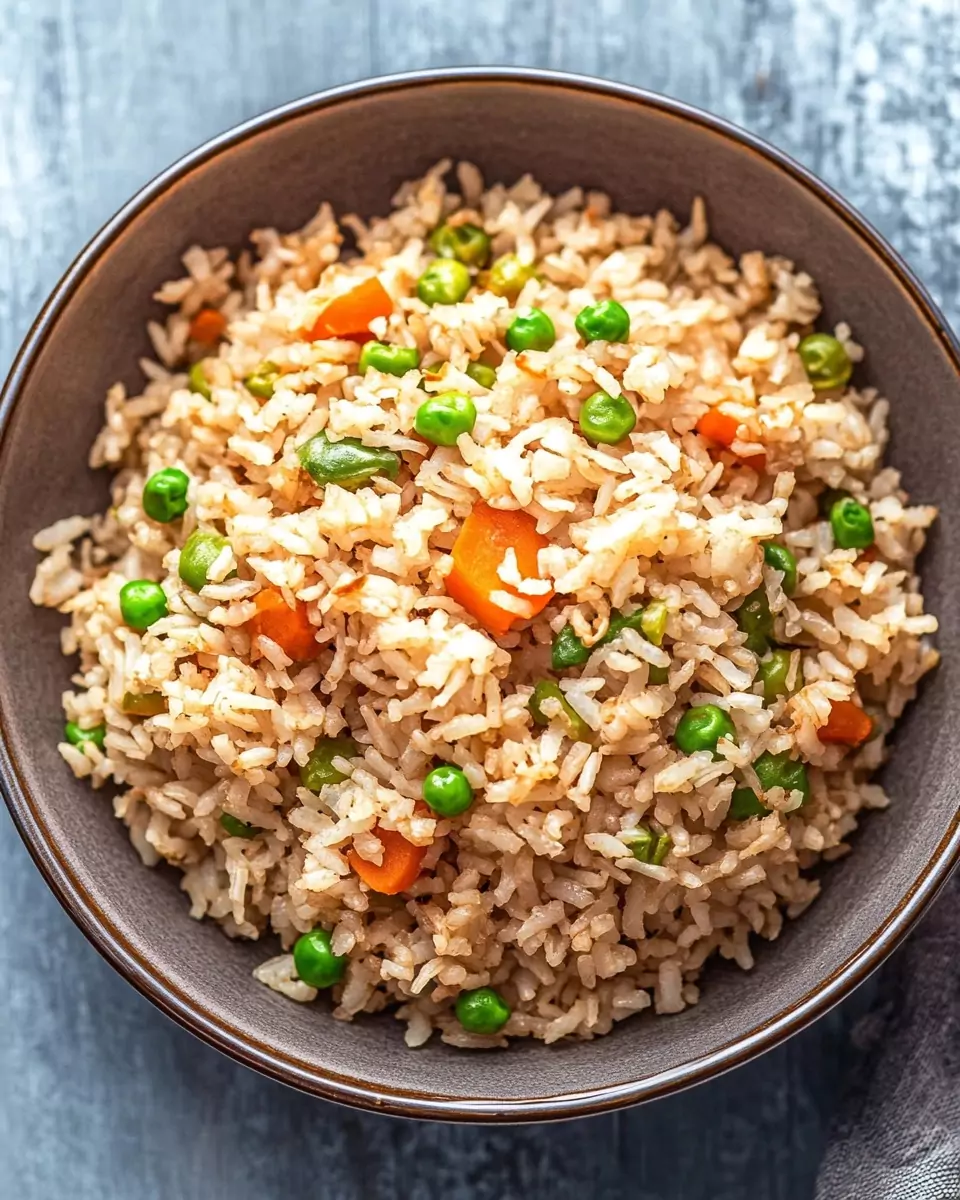
Why You’ll Love This Recipe
- Quick and Easy: Ready in just 35 minutes, this recipe is perfect for busy nights.
- Versatile: Enjoy it as a main dish or pair it with your favorite proteins and sides.
- Customizable: Add your choice of vegetables, protein, or sauces for endless variations.
- Meal Prep-Friendly: Reheats beautifully for easy lunches or dinners throughout the week.
Preparation Phase & Tools to Use
Essential Tools and Equipment
- Large Skillet or Wok: The wide surface area ensures even cooking and prevents sticking.
- Wooden Spatula: Ideal for stirring and tossing ingredients without scratching the pan.
- Mixing Bowls: Keep all ingredients prepped and ready for a smooth cooking process.
- Measuring Spoons and Cups: For precise measurements of sauces and seasonings.
Preparation Tips
- Use Cold Rice: Cook the rice ahead of time and refrigerate it for at least an hour (overnight is even better). Cold rice prevents clumping and creates the perfect texture for fried rice.
- Softened Butter: Let the butter sit at room temperature or microwave it briefly to make it easy to mix with soy sauce.
- Prepped Ingredients: Chop, whisk, and measure all ingredients before starting to cook for a stress-free experience.
Ingredients
Here’s everything you’ll need to create this delicious and versatile fried rice recipe:
- Rice:
- 4 cups cooked short-grain white rice (cold; long-grain or jasmine rice also works).
- Egg:
- 1 large egg, whisked or scrambled.
- Vegetables:
- 1/2 cup chopped carrots (fresh or frozen).
- 1/2 cup peas (frozen recommended).
- 1/2 cup white onion, finely chopped.
- Butter:
- 4 tablespoons unsalted butter, softened.
- Soy Sauce:
- 2 tablespoons low-sodium soy sauce (adjust to taste).
- Oil:
- 2–3 tablespoons peanut, canola, or vegetable oil (for frying).
- Sesame Oil (optional):
- 2 teaspoons for added flavor and aroma.
Step-by-Step Directions
1. Prepare the Rice
Cook your rice according to package instructions. Once done, transfer it to a large plate or baking sheet and allow it to cool completely. Refrigerate for at least 1 hour or overnight to ensure the rice is firm and perfect for frying.
2. Soften the Butter
Let the butter sit at room temperature to soften. Alternatively, microwave it in short 10-second intervals until soft. Mash the butter with a fork and mix it with the soy sauce. It’s fine if the mixture doesn’t combine fully.
3. Cook the Egg
- Heat 1 tablespoon of oil in a large skillet or wok over medium heat.
- Pour in the whisked egg and scramble it gently, breaking it into small chunks.
- Once cooked, remove the scrambled egg from the skillet and set it aside.
4. Cook the Vegetables
- Add another splash of oil to the skillet.
- Sauté the chopped carrots, peas, and onions for about 4 minutes, or until tender.
- Season with a pinch of salt and pepper to enhance their flavor.
- Remove the vegetables from the skillet and set them aside with the scrambled egg.
5. Fry the Rice
- Add another tablespoon of oil to the skillet and increase the heat to medium-high.
- Add the cold rice to the skillet and use your spatula to break up any clumps.
- Toss the rice every 30 seconds, allowing it to heat through and lightly brown (about 4–5 minutes).
6. Season the Rice
- Drizzle the butter-soy sauce mixture over the rice and toss until all the grains are evenly coated.
- Cook for another 1–2 minutes, ensuring the rice is uniformly colored and aromatic.
7. Combine Everything
- Return the scrambled egg and sautéed vegetables to the skillet.
- Drizzle with sesame oil (optional) for added flavor and toss to combine.
- Taste and adjust the seasoning with additional soy sauce if needed.
8. Serve Immediately
Serve the fried rice hot as a main dish or pair it with your favorite sides for a complete meal. Enjoy!
Notes
- Cold Rice: Always use cold, leftover rice for fried rice. Freshly cooked rice tends to be sticky and clumps together.
- Soy Sauce: Start with low-sodium soy sauce to control the saltiness. Add more to taste as needed.
- Vegetables: Frozen peas and carrots are convenient, but feel free to substitute fresh vegetables like bell peppers, broccoli, or zucchini.
- Wok or Skillet: A wok is ideal for this recipe, but a large skillet works just as well. Use plenty of oil to prevent sticking.
- Ingredient Prep: Keep all ingredients prepped and in small bowls to make the cooking process smoother and faster.
Serving Suggestions
This hibachi-style fried rice pairs wonderfully with a variety of dishes, transforming it from a humble side into a complete feast. Here are eight delicious serving ideas to inspire you:
- Teriyaki Chicken Skewers: Juicy, grilled skewers glazed with a sweet and savory teriyaki sauce.
- Garlic Butter Shrimp: Succulent shrimp sautéed in garlic butter for a luxurious pairing.
- Steamed Dumplings: Soft and flavorful dumplings filled with pork, vegetables, or tofu.
- Miso Soup: A warm, comforting soup that balances the richness of fried rice.
- Vegetable Tempura: Crispy, golden-battered veggies like sweet potatoes and zucchini.
- Grilled Tofu with Sesame Glaze: A vegan option that complements the rice’s umami notes.
- Asian Cucumber Salad: Light and refreshing, with a tangy sesame dressing.
- Spring Rolls with Dipping Sauce: Crispy rolls filled with veggies or meat, served with sweet chili sauce.
Common Mistakes to Avoid & How to Perfect the Recipe
Mistake 1: Using Freshly Cooked Rice
- Why It’s a Problem: Freshly cooked rice is too moist and sticky, resulting in clumpy fried rice.
- Solution: Always use cold, leftover rice. Refrigeration dries the rice, giving it the ideal texture for frying.
Mistake 2: Overcrowding the Pan
- Why It’s a Problem: Too many ingredients in the pan can lead to steaming instead of frying.
- Solution: Cook in smaller batches if necessary, especially if you’re doubling the recipe.
Mistake 3: Not Using Enough Oil
- Why It’s a Problem: Insufficient oil can cause the rice to stick and burn, affecting the flavor and texture.
- Solution: Generously oil the pan, and add more as needed during cooking.
Mistake 4: Skipping Prepped Ingredients
- Why It’s a Problem: Cooking fried rice requires quick, high-heat tossing, so pausing to chop or measure can result in overcooked or burnt ingredients.
- Solution: Have all ingredients measured, chopped, and ready to go before turning on the heat.
Mistake 5: Not Using High Heat
- Why It’s a Problem: Low heat prevents the rice from crisping and achieving that signature smoky flavor.
- Solution: Use medium-high to high heat and a wok or skillet with good heat distribution.
Mistake 6: Underseasoning the Rice
- Why It’s a Problem: Bland rice won’t deliver the bold flavors you expect from fried rice.
- Solution: Start with a small amount of soy sauce, taste, and adjust as needed. Add salt, pepper, or even a splash of sesame oil for extra depth.
Mistake 7: Overcooking the Egg
- Why It’s a Problem: Overcooked egg becomes rubbery and detracts from the dish’s texture.
- Solution: Scramble the egg gently and remove it from the pan as soon as it sets.
Side Dish Recommendations
For a complete and balanced meal, consider these flavorful and diverse sides that pair beautifully with fried rice:
- Korean BBQ Beef (Bulgogi): Sweet and savory marinated beef slices that add depth to your plate.
- Sweet and Sour Chicken: A classic takeout favorite that complements the rice’s savory flavors.
- Spicy Kimchi: Fermented cabbage with a kick of heat to contrast the mild rice.
- Honey Garlic Pork Chops: Tender, juicy pork with a sticky-sweet garlic glaze.
- Seaweed Salad: A tangy and umami-rich option to bring a refreshing element.
- Chicken Katsu: Crispy breaded chicken cutlets with tonkatsu sauce for dipping.
- Thai Green Curry: Creamy and spicy, this dish adds bold flavors to the meal.
- Egg Drop Soup: A light and silky soup to round out your meal with warmth and comfort.
Recipe Tips for the Best Fried Rice
1. Use a Wok for Authentic Results
A wok’s high, sloped sides allow for better tossing and even heat distribution. If you don’t have one, a large skillet works well too.
2. Preheat Your Pan
Make sure your pan or wok is hot before adding oil or ingredients. This ensures proper frying and prevents sticking.
3. Customize Your Protein and Veggies
- Add shrimp, chicken, beef, or tofu to make the dish heartier.
- Substitute veggies like bell peppers, broccoli, or mushrooms for added variety.
4. Don’t Skip Sesame Oil
A drizzle of sesame oil adds depth and richness to the fried rice. While optional, it elevates the flavor significantly.
5. Play with Seasonings
Experiment with garlic powder, ginger, or even a splash of oyster sauce for extra layers of flavor.
Storage and Reheating Instructions
Storage Tips
- Store leftover fried rice in an airtight container in the refrigerator for up to 4 days.
- Avoid leaving the rice at room temperature for long periods to prevent spoilage.
Reheating Methods
- Stovetop: Heat a skillet over medium heat, add a splash of oil or soy sauce, and stir-fry the rice until hot.
- Microwave: Transfer to a microwave-safe dish, cover with a damp paper towel, and heat in 30-second intervals, stirring between each.
- Oven: Spread the rice on a baking sheet, cover with foil, and bake at 350°F (175°C) for about 10 minutes.
Freezing Fried Rice
- Fried rice can be frozen for up to 3 months.
- Portion the rice into freezer-safe containers or bags for easier reheating.
- Thaw in the refrigerator overnight before reheating on the stovetop or microwave.
Frequently Asked Questions (FAQs)
Q: Can I use brown rice instead of white rice?
A: Absolutely! Brown rice works great and adds a nutty flavor and extra fiber to the dish.
Q: How do I make this recipe vegan?
A: Skip the egg and use plant-based butter or oil instead of traditional butter. You can also add more vegetables or tofu for a protein boost.
Q: What other vegetables can I use in fried rice?
A: Bell peppers, broccoli, zucchini, spinach, or even corn are excellent options. Fresh or frozen, they’ll both work beautifully.
Q: How do I prevent fried rice from becoming mushy?
A: Always use cold, leftover rice. Freshly cooked rice retains moisture and can become sticky during frying.
Q: Can I make fried rice without soy sauce?
A: Yes, you can substitute soy sauce with tamari, coconut aminos, or liquid aminos for a similar flavor.
Q: Can I double this recipe?
A: Yes, but make sure to cook the rice in batches to avoid overcrowding the pan, which can lead to steaming instead of frying.
Q: What’s the secret to smoky, restaurant-style fried rice?
A: High heat and tossing the rice frequently help develop the smoky flavor you love in restaurant versions.
Q: Is fried rice gluten-free?
A: Fried rice can easily be made gluten-free by using tamari or gluten-free soy sauce.
Conclusion
This fried rice recipe is your ticket to delicious, restaurant-quality fried rice made right in your own kitchen. It’s quick, versatile, and easy to adapt to your preferences, whether you want to keep it simple or load it up with proteins and veggies. Perfect for weeknight dinners, meal prep, or as a side for your favorite Asian-inspired dishes, this recipe will quickly become a household favorite.
Try this recipe today and bring the taste of hibachi-style fried rice to your table. Serve it fresh and hot, savoring the rich, savory flavors with every bite. Better than takeout and endlessly customizable, it’s a dish you’ll return to again and again!
Fried Rice Recipe
Ingredients
- 4 cups cooked short-grain white rice long-grain or jasmine rice also works
- 1 egg whisked/scrambled
- 1/2 cup chopped carrots fresh or frozen
- 1/2 cup peas frozen recommended
- 1/2 cup white onion chopped
- 4 tablespoons unsalted butter softened
- 2 tablespoons low-sodium soy sauce
- 2 –3 tablespoons peanut canola, or vegetable oil
- 2 teaspoons sesame oil optional
Instructions
- Prepare the Rice: Cook the rice according to package instructions, then chill it in the refrigerator for at least 1 hour, or overnight, to ensure it’s cold and firm for frying.
- Soften the Butter: Leave the butter at room temperature to soften, or microwave it in short intervals until soft. Mash it with a fork and mix it with the soy sauce. It’s okay if it doesn’t combine fully.
- Cook the Egg: Heat 1 tablespoon of oil in a large skillet or wok over medium heat. Add the whisked egg and scramble it, breaking it into small chunks. Remove the scrambled egg from the skillet and set it aside.
- Season the Rice: Drizzle the butter-soy sauce mixture over the rice and toss to coat evenly. Cook until the rice is uniformly colored, with no visible white grains.
Notes
Vegetables: Frozen peas and carrots save prep time, but fresh veggies can also be used.
Soy Sauce: Start with low-sodium soy sauce to control the saltiness. Add more to taste as needed.
Wok Tip: A wok is ideal for this recipe, but a large skillet works too. Use plenty of oil to prevent sticking.
Prepped Ingredients: Keep everything ready in small bowls for easier and faster cooking.
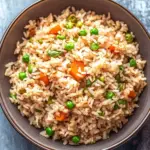
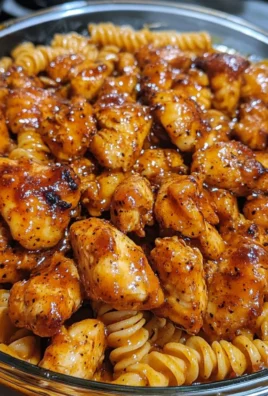
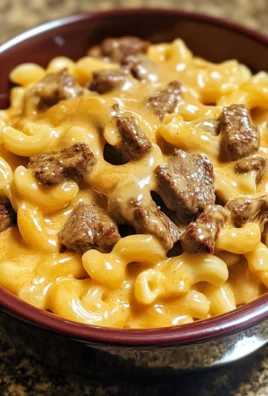
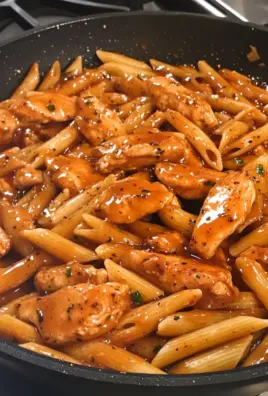
Leave a Comment